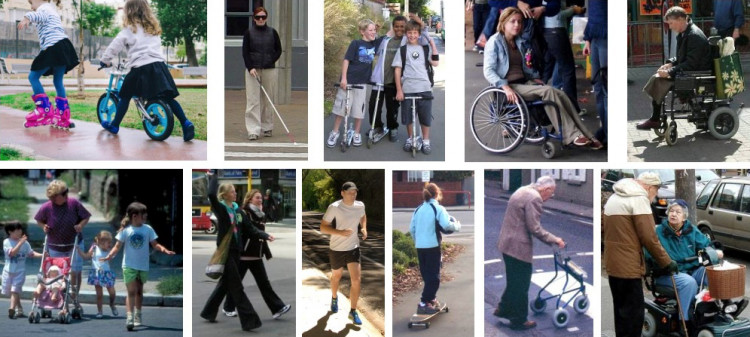Walking is such a basic human activity that it has often been overlooked when planning for transport and has been viewed as a second-class form of travel. However, the right to walk is a fundamental element of society, particularly in urban environments, and is embedded in numerous public policies.
The use of walking for transport is declining. Even so, walking remains a key element of a balanced transportation system and is a focus of many towns and cities to prioritise. Overall, it is still the second most popular form of travel in New Zealand. Nearly one in five of all household trips is made on foot. For the 6.6% of households that have no car [1], for those in households without car access for much of the day, and for those who cannot, or choose not to drive, walking is an especially vital mode of transport.
Walking is also included in most trips made by other modes. People walk for many reasons; from their cars to their workplace, from home to the bus stop or to a café for lunch. Whatever the main means of travel, walking is usually the first and last mode used, providing an important link between land use and motorised travel. It is also healthy, inexpensive and very environmentally friendly.
Understanding pedestrian experiences, behaviour, needs and barriers to walking can help shape our urban environments to encourage more people to enjoy them as pedestrians. [2]
Although much of the guide focuses on walking for transport, people walk for pleasure or exercise on all types of infrastructure. In many ways, walking is the glue that holds together the transport system, connecting all the different modes and places within it. The attractiveness and quality of our streets and public spaces is, therefore, key to getting more people to walk. The walking network needs to cater for a vast range of activities and possible destinations.
With growing environmental and health issues, investing in changes to our built environment that reduce peoples’ dependence on cars is becoming increasingly important.
The dual function of walking as a recreational activity, as well as a mode of transport, highlights the potential for walking to create healthier, safer, and more accessible communities.
A ‘pedestrian’, as defined in section 1.6 of the Land Transport (Road User) Rule 2014, means ‘a person on foot on a road, and includes a person in or on a contrivance equipped with wheels or revolving runners that is not a vehicle.’ [3]
Pedestrians are road users with the same general responsibilities as other road users. A pedestrian can include a person walking or running, a person pushing a pram, a person in a wheelchair and a number of other users. Users of skateboards, skates and scooters are not pedestrians as defined by law but are permitted on the pedestrian network.
The New Zealand Government is currently considering the Accessible Streets package of legislative changes, which includes renaming ‘wheeled recreational devices’ to ‘transport devices’.

Pedestrians and other path users have a wide range of abilities and needs.
The various types of road users are grouped in legislation and where they can operate are outlined in a Waka Kotahi Research report[4]. Please refer to current legislation as this is subject to change.
The pedestrian network is made up of multiple components including footpaths, shared paths, road crossings and intersections, bridges and underpass / tunnels, shared spaces, laneways, unpaved walking tracks, stairs and ramps, elevators and escalators. Those on transport devices may also use the road. Note that a road is broadly defined, including beaches and ‘a place to which the public have access, whether as of right or not’, which would include park pathways and trails[5].






[1] Statistics NZ. (2018). Census(external link)
[2] NZ Transport Agency. (2019). The Pedestrian Experience literature review
[3] Section 1.6 of the Land Transport (Road User) Rule 2004. Note that the definition of a pedestrian may change to include power wheelchairs as a result of the Accessible Streets package of legislative changes.
[4] ViaStrada. (2017). Regulations and safety for electric bicycles and other low-powered vehicles Waka Kotahi NZ Transport Agency Research Report 621
[5] Definition of a road as per Land Transport (Road User) Rule 2004(external link)